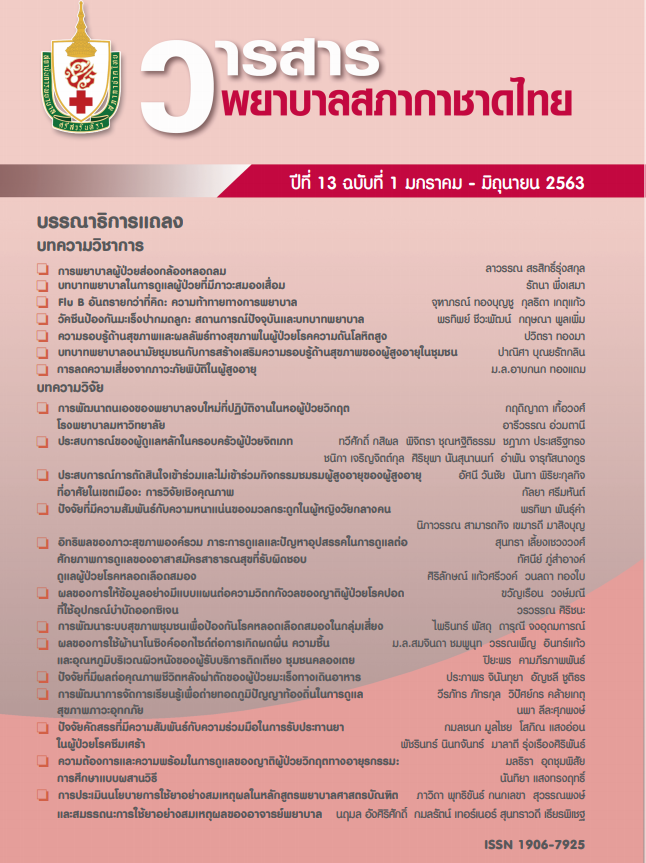An Evaluation of the policy of integrating RDU curriculum into the Bachelor of Nursing Science Program and RDU competency of Nurse Instructors
Keywords:
rational drug use, policy, competency, nursing science programAbstract
This study aimed to evaluate the policy of integrating RDU curriculum into the Bachelor of Nursing Science program and RDU competency of nurse instructors. The sample comprised 1,052 administrators and nursing instructors from 86 nursing institutions. The data were collected using an online questionnaire and analyzed using frequency, percentages, means, and standard deviations.
The results show that most respondents are aware of the policy of integrating RDU curriculum into the Bachelor of Nursing Science program (98.76%). Most of nursing institutions had a clear written policy and implemented this policy at a practical level (53.52%), and determined the objectives and learning outcomes of RDU competencies in the curriculum (75.67%). Nurse instructors had overall RDU competencies at a high level (Mean = 4.25, SD = 0.82). When considering each category, the results showed that competency in evaluating medication-related problems before using a drug with patients had the highest mean score (Mean = 4.40, SD = 0.73), followed by competency in drug administration with correct prescription (Mean = 4.34, SD = 0.76). The competency in continuing to develop knowledge and ability in drug administration had the lowest mean (Mean = 4.11, SD = 0.83).
References
2. The ASEAN Secretariat. Rational use of medicines in the ASEAN region [Internet]. 2017 [cited 2020 Apr 21]. Available from: https://asean.org/wp-content/uploads/2017/04/4.-March-2017-Rational-Use-of-Medicines-in-the-ASEAN-Region.pdf
3. Pumart P, Phodha T, Thamlikitkul V, Riewpaiboon A, Prakongsai P, Limwattananon S. Health and economic impacts of antimicrobial resistance in Thailand: a preliminary study. Journal of Health Systems Research 2012;6(3):352-60 (in Thai).
4. Health Systems Research Institute and Coordination and Integration Committee on Antimicrobial Resistance. Thailand national strategic plan on antimicrobial resistance 2017-2021 [Internet]. 2017 [cited 2020 Apr 30]. Available from: https://kb.hsri.or.th/dspace/handle/11228/4807?show=full
5. World Health Organization. Rational use of medicines. Fact sheet no.38 [Internet]. 2010 [cited 2010 Mar 20]. Available from: www.who.int/mediacentre/factsheets/fs338/en
6. Rational Use of Drug Subcommittee. Teacher’s guide for promoting rational drug use. Nonthaburi: Food and Drug Administration, Ministry of Public Health; 2017. (in Thai)
7. National Drug System Development Committee. National drug policy A.D. 2011 and National drug system development strategy A.D. 2012-2016. (2nded.). Bangkok: Aksorn Graphic and Design Publication. (in Thai)
8. Thailand Nursing and Midwifery Council. Conclusion integrating the rational drug use curriculum into the bachelor of nursing science program, 2018 [Internet]. 2018 [cited 2019 Mar 29]. Available from: https://www. tnmc.or.th/news/110 (in Thai)
9. Thailand Nursing and Midwifery Council. The handbook of learning and teaching management on the rational drug use into the Bachelor of Nursing Science Program. Chonburi: Danext Intercoperation; 2019. (in Thai).
10. Stufflebeam DL. The CIPP model for evaluation. In: Kellaghan T, Stufflebeam DL, editors. International handbook of educational evaluation. Dordrecht: Kluwer International Handbooks of Education; 2003. p. 31-56.
11. Panakul S. Curriculum evaluation 6th ed. Bangkok: Ramkhamhaeng University; 2010.
12. Rattanamanee N, Phasunon P. Response rate in qualitative research. Journal of Humanities and Social Sciences Thonburi University 2019;13(3):181-88. (in Thai)
13. Srisa-ard B. Preliminary research. (9th ed.). Bangkok: Suviriyasarn; 2011. (in Thai)
14. Aziz S, Mahmood M, Rehman Z. Implementation of CIPP model for quality evaluation at school level: a case study. JoEED 2018;5(1):189-206.
15. Bullock S, Manias E. The educational preparation of undergraduate nursing students in pharmacology: a survey of lecturers’ perceptions and experiences. J Adv Nurs 2002;40(1):7-16.
16. Thirawanutpong PH, Bunprom PU. The Development of Lecturer’s Potential in higher education institutions. SKRU Academic Journal 2018;8(1):33-40. (in Thai)
17. Intahphuak S. Medication errors reduction: appling nursing process in drug administration. Journal of Nursing Science & Health 2014;37(4):139-46. (in Thai)
18. Tipkanajanaraykha K, Saleekul S. Role of nurses in prevention and management of inappropriate medication use in older adults. Journal of The Royal Thai Army Nurses 2019;20(1):31-9. (in Thai)
19. Sornkrasetrin A, Rungnoei N, Thongma N, Klinchat R, Rajataramya B, Nitirat P. Factors predicting the rational antibiotic use among nursing students. The Journal of Baromarajonani College of Nursing, Nakhonratchasima 2019;25(1):43-59. (in Thai)
20. Jongpantanimit P. Risk management in high alert drug use among nursing students.Journal of Phrapokklao Nursing College 2018;29(1):204-14. (in Thai)
21. Talordpong P, Pibanwong P. Roles of nursing practitioner in the use of drugs in elderly patients. Vajira Medical Journal: Journal of Urban Medicine 2018;62(6):473-82. (in Thai)
22. Driessnack M. Interprofessional Practice and Education (IPE): a primer. J Nurs Sci 2018;36(3):4-8. (in Thai)
23. Hermann CP, Head BA, Black K, Singleton K. Preparing nursing students for interprofessional practice: the interdisciplinary curriculum for oncology palliative care education. J Prof Nurs 2016;32(1):62–71.
24. Sarakshetrin A, Sriyasak A,Ketin V,Rongmuang D. A development of interprofessional education learning model for health promotion among the elderly in the community. Journal of Health and
Nursing Research 2019;35(2):140-52. (in Thai)
25. Sethasathien S. A model of interprofessional education (IPE) in Department of Physical Medicine and Rehabilitation, Udonthani Hospital. J Thai Rehabil Med 2015;25(2):65-70.
doi:10.14456/jtrm.2015.12
26. Sulosaari V, Kajander S, Hupli M, Huupponen R, Leino-Kilpi H. Nurse students’ medication competence- an integrative review of the association factors. Nurse Educ Today 2012;32(4):399-405.
27. Powell B, Conrad E. Utilizing the CIPP model as a means to develop an integrated service-learning component in a university health course. J Health Educ Teach 2015;6(1):21-32.
Downloads
Published
Issue
Section
License
เนื้อหาบทความหรือข้อคิดเห็นต่างๆ ในวารสารพยาบาลสภากาชาดไทยนี้ เป็นความคิดเห็นของผู้เขียนบทความ ไม่ใช่ความเห็นของกองบรรณาธิการ หรือสถาบันการพยาบาลศรีสวรินทิรา สภากาชาดไทย






